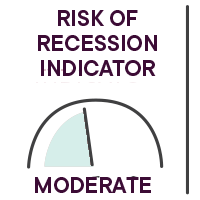Yann Furic
B.B.A., M. Sc., CFA®
Senior Portfolio Manager, Asset Allocation and Alternative Strategies
What moved the markets:
No rate hike by the Bank of Canada or the Fed.
Canadian economy slowing, but not in recession.
Solid growth of the U.S. economy.

|
OVERVIEW OF GLOBAL EQUITY MARKETS |
||||
|
Country |
Index |
Return |
Change |
Year-to-date |
|
Canada |
S&P/TSX |
0.55% |
|
0.55% |
|
United States |
S&P 500 |
3.03% |
|
3.03% |
|
|
Nasdaq |
2.38% |
|
2.38% |
|
International stock markets |
EAFE |
1.91% |
|
1.91% |
|
Emerging markets |
|
-3.38% |
|
-3.38% |
|
China |
MSCI China |
-9.43% |
|
-9.43% |
* All percentages are in Canadian dollars. Source: Morningstar Direct.
Results – Canadian bonds
The FTSE Canada Universe Bond Index has posted a negative return of 1.37% year to date (at January 31, 2024).
Source : Morningstar Direct.
Our analysis of events

Good start to the year for developed country stock markets
Since January, stock markets have posted positive results,1 with the S&P 500 up 6.1%, international markets (MSCI EAFE), 1.43% and the S&P/TSX Composite, 0.85%. Emerging markets bucked this trend, however, posting a negative return1 of 1.52%, mainly due to China’s poor performance (-8.72%). Rising medium- and long-term interest rates resulted in a decline (-1.55%) in the FTSE Canada Universe Bond Index.
1 All returns are in Canadian dollars.
Outlook for central banks
The U.S. Federal Reserve kept its key interest rate unchanged and suggested that a rate cut in March was no longer part of its baseline scenario. Rate cuts are expected to begin later this year, in the second half.
The Bank of Canada also kept its policy rate unchanged and is considering possible rate cuts later in the year.
- In Canada, current market expectations for lower rates are for a first cut in June, followed by three to four 0.25% cuts over the rest of 2024.
- In the U.S., a first rate cut is expected in May, with further cuts totalling over 1% in 2024.
- In Europe, a first rate cut should be announced in June, followed by further cuts totalling 1.25% by the end of 2024.
The annual inflation rate in Canada was 3.4% in December 2023, up from the previous month but in line with market expectations. In the United States, the annual inflation rate rose to 3.4% in December 2023 from 3.1% in November, exceeding market expectations.
Possible economic scenarios in 2024
- The most positive scenario would be a rate cut due solely to a decline in inflation, with no pronounced economic slowdown.
- Should the U.S. economy remain strong, the Fed could decide to hold off on some of the rate cuts priced in by the market. This situation would have a negative impact on the Canadian dollar if the Bank of Canada were to cut rates to avoid a major reduction in household spending during the wave of mortgage renewals in 2025-2026.
- Alternatively, rates could be cut to revive an economy facing a severe recession.
- Finally, we could see re-accelerating inflation while the economic situation deteriorates. This would indicate a state of stagflation, which would be the most negative scenario.
The markets will therefore continue to react to inflation, anticipating declines beginning late in the first half of 2024.
Keep an eye on mortgage renewals
In Canada, mortgage terms are generally five years: renewals of mortgages issued in 2020 and 2021 will therefore involve higher payments in 2025 and 2026. Note, however, that wage increases since 2020 should reduce the impact of this shock, and mortgage rates should be lower than in 2023. The labour shortage should also limit job losses and support the economy.
Hope for SMEs
We should also mention that a rate cut is good news for small and medium-sized businesses, as it would make it easier for them to find financing, and thus actively participate in the economic recovery.
At present, economic data seem to be pointing to a slowdown. Rate hikes are gradually working their way through the economy, and their dampening effect is reducing consumption of non-essential goods and services.
Employment situation
In January, Canada’s unemployment rate rose to 5.7% from 5.8% the previous month, exceeding market expectations. 37,300 jobs were created in January, but these were mainly part-time (+48,900), while full-time jobs were down (-11,600). Wage inflation was up by 5.3% year-on-year, which for the Bank of Canada is still too high.
The latest U.S. employment data came as a surprise, with 353,000 jobs added versus forecasts of 185,000. Wage growth is still too high at 4.5%, but the number of hours worked is falling. The U.S. economy continues to grow at a faster pace (Q4 GDP +3.3% annualized).
Economic indicators
Global Purchasing Managers’ Index ![]()
Manufacturing indicators are improving, but remain weak. Services growth continues, but remains modest in Europe.
Inflation rate ![]()
The inflation rate is still too high, but certain indicators are moving in the right direction. Wage inflation in Canada is still too strong.
Benchmark rates in Canada, Europe and the United States ![]()
If interest rates remain at current levels for an extended period, this will have a major impact on household and business spending when loans are renewed. This situation will further dampen personal and investment.

Our strategic monitoring
In 2023 and again early this year, we have systematically maintained a cautious positioning.
We are monitoring inflation as well as the leading indicators for manufacturing production, the services sector and employment. A deterioration in these numbers would prompt us to be even more cautious.
A notable improvement in the manufacturing indices and a return to an inflation rate of 2% would be strong signs of an economic recovery, but above all of a possible soft landing for the economy.
Caution and risk management remain our priorities.
Our tactical approach
In January, we maintained a higher weighting in equities than in bonds.
We are maintaining our position in small-cap stocks, which react well to rate cuts. We also maintained our overweight position in Japan relative to Europe, since the Japanese economic outlook seems brighter to us.
Tactically, we maintained our position in U.S. large-cap growth stocks, which react positively to stabilizing interest rates, as well as in stocks with a track record of dividend growth which are more defensive.
We continue to favour stocks in developed countries.
After the Bank of Canada’s policy rate increase in early June 2023, we took a position in 10-year Canadian bonds and have increased it several times, since we believe that longer-term yields will peak over the next few months and then stabilize or decline.
To learn how our funds performed:
View the returns
Main risks
- An overly restrictive monetary policy could cause a major recession or other problems, like the U.S. regional bank crisis.
- High interest rates for an extended period would reduce corporate profits and sharply curtail household spending.
- The possibility of an episode of stagflation, i.e. anemic economic growth and high inflation, persists. This situation is negative for stock markets.
- The Israeli-Palestinian conflict could escalate and spread throughout the Middle East.
- The conflict in Ukraine could spread to other European countries.
- There is also a risk that tensions could worsen between China and the United States over Taiwan.
Senior Manager, Asset Allocation and Alternative Strategies
Data source : Bloomberg
The opinions expressed here and on the next page do not necessarily represent the views of Professionals’ Financial. The information contained herein has been obtained from sources deemed reliable, but we do not guarantee the accuracy of this information, and it may be incomplete. The opinions expressed are based upon our analysis and interpretation of this information and are not to be construed as a recommendation. Please consult your Wealth Management Advisor.




















